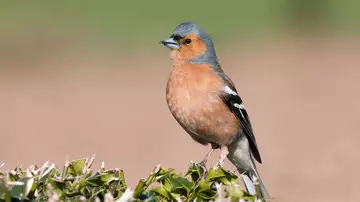
There are many diseases affecting British birds, but Chaffinches are anything but chuffed as leg lesions are found to peak during winter season.
Observations collected by citizen scientists have helped ZSL vets investigate the occurrence of a condition that affects British finches. The latest study published in Scientific Reports shows that reports of leg lesions peak in winter, from March to November, which may be linked to the annual influx of migratory Chaffinches from mainland Europe.

Evidence of diseases found in British birds
Leg lesions, commonly known as ‘scaly leg’ or ‘tassel foot’, are growths on the legs and feet seen in finches in Britain and mainland Europe. Leg lesions in Chaffinches are one of the most frequently observed signs of diseases found in British garden birds, and have been known to occur for decades. Up until now there has been no large-scale study of this condition, and it has been unclear if it is more common at particular times of the year or in particular regions of Great Britain. Weekly records of the presence of leg lesions in garden birds, received from volunteers taking part in the British Trust for Ornithology’s (BTO) Garden BirdWatch survey, alongside reports from members of the public received via the Garden Wildlife Health website, have allowed us to answer these questions for the first time.
Each week an average of 3 – 4% of BTO Garden BirdWatchers recording Chaffinches see a bird with leg lesions in their garden, with a widespread distribution across Great Britain. However, there is clear seasonality in reporting with a peak from November to March. Whilst Chaffinches occur in Britain throughout the year, higher numbers of these birds are reported during the winter months, as a result of an influx of migratory birds from mainland Europe, and it is thought that this is related to the winter peak in leg lesions.

Chaffinches are by far the most likely bird you’ll see with leg lesions in your garden, but this condition has been reported less commonly in a number of other finch species, including Brambling, Bullfinch, Goldfinch and Greenfinch. Results from post-mortem examinations of just over a thousand finches in Great Britain have identified two causes of this type of leg lesion; a virus (Fringilla coelebs papillomavirus) and mites (Cnemidocoptes).
Dr Becki Lawson from ZSL's Institute of Zoology said: “Leg lesions in finches are highly visible and can generate public concern for animal welfare. Whilst birds with severe lesions can become lame or increasingly vulnerable to predation, most affected birds continue to behave normally. The majority of reports involve individual affected birds rather than outbreaks involving large numbers of birds. Our study did not find leg lesions as a common cause of death and there is no evidence that this condition poses a threat to conservation."
Subscribe to ZSL conservation news
Kate Risely from BTO commented “Thousands of people report their garden wildlife sightings to Garden BirdWatch every week. While it can be upsetting to see birds with health problems, these results show that regular reporting of symptoms can help us learn about large-scale patterns when used in conjunction with one-off reports. We are very grateful to everyone who reports their sightings to BTO and to Garden Wildlife Health.”
Both the mite and viral infection that cause leg lesions are thought to be transmitted by contact. Good hygiene measures such as cleaning bird feeders are recommended as a routine to minimise transmission of disease at feeding stations.
Learn more about maintaining good garden hygiene and help our research on our Garden Wildlife Health project
This study was conducted in collaboration with scientists at the British Trust for Ornithology, the Complutense University of Madrid and Linnaeus University, among others.
